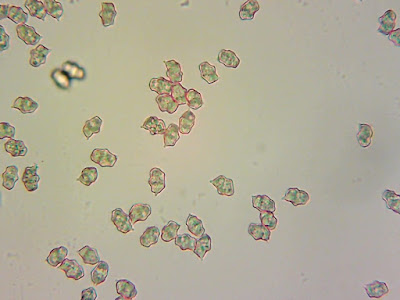After a chaotic week, I failed to check either the weather forecast or my emails ahead of the Sussex Fungus Group survey at Ditchling Beacon this morning; so I didn't know torrential rain & thunderstorms were forecast and it was cancelled.
Hence I was at the bottom of Ditchling Beacon this morning ... and the rain seemed to have slackened off for a bit ... I thought I'd go for a mooch around the old chalk pits.
Most of the mushrooms I saw looked completely mullered, but a plucky little white waxcap had weathered the previous night's storms.
No scent, so it was one of those Snowy Waxcap Cuphophyllus virgineus ones.
I almost missed this moss-coloured mushroom, nestled amongst some longer vegetation...

Those are the distinctive tones of Mouse-pee Pinkgill Entoloma incanum. The yellow-green stipe and bluish-green staining on this species when bruised (which you can just about see in the second photo below, where the stipe meets the gills) is just WILD. I love it. Makes this mushroom look like a total raver.
But I found out earlier this week ID'ing E. incanum isn't quite so simple any more...
Given my penchant for grassland fungi, I couldn't resist placing an order for the new Entoloma book by Machiel E. Noordeloos and it arrived on Tuesday from Summerfield Books. It's a beast!
On page 259 (of 968 !!!), Noordeloos explains:
"Entoloma incanum is one of the iconic species of subgenus Cyanula with its yellow-green tinges, blue-green discolouration at the stipe base and strong smell, which reminds of that of mouse-nests. Until recently the species was therefore easily identifiable in the field. However, during the phylogenetic study of the subgenus Cyanula, two genotypes fitting the current morphological concept of Entoloma incanum were revealed ... indicating that we have two different species in Europe. As a result, E. verae was published (Crous et al., 2021) as new to science."
He goes on to explain that the two species are thought to be separable on spore size.
Happily, Noordeloos's book also includes guidance on how to measure Entoloma spores, because this has always been a mystery to me.
 |
| Figure from Fungi Europaei: Entoloma s.l. 5B by M.E. Noordeloos (2022). (c) Lidia Carla Candusso. |
So this is what the spores from my collection look like:
And these are my measurements:
So I think this makes my collection Entoloma incanum sensu stricto.
***
On one of the banks in the old chalk pits, I found the remains of a mushroom I thought might have been one of those nice 'big blue pinkgills'. But not enough of it to make me want to attempt an ID!
Then Martyn Ainsworth appeared ... so I seized my opportunity to cross-question him about the Cuphophyllus I had found earlier (first two photos, above).
I wondered if I should be calling it "var. fuscescens'... But Martyn explained that phylogenetic work (in progress) has shown that "Cuphophyllus virgineus sensu lato" clusters into multiple clades and collections with a brownish central spot on the cap show up in several of these clades. So I can call it var. fuscescens (as described in Boertmann's The Genus Hygrocybe, 2nd Edition) if I want to – but it sounds like Science is going to tell us that these visual characters / morphological concepts don't map across neatly to DNA-based species concepts (so those little brown spots in the centre of the cap might turn out to be kind of irrelevant for species-ID / taxonomic purposes).
I think I'll keep things simple and call it Cuphophyllus virgineus s.l..
***
Martyn recalled that there's a field towards the bottom of Ditchling Beacon where he's found Entoloma bloxamii before, so we went to check that out.
We found loads! Reckon we must have seen twenty, at least.
 |
| Collection 1. Spores shown below. |
With those slight lilac tones, Martyn advised that a check on spore size could confirm the ID as Entoloma bloxamii sensu stricto. (For more info see the paper from Field Mycology on Big Blue Pinkgills, here.)
In E. bloxamii, the spores often exceed 8 μm. That certainly looks to be the case for my collection 1, above.
I looked at a few different collections, pictured below in terrible light, and they all seemed to be showing similar colouration: greyish and slightly lilac tones (not the dark or strikingly blue tones of E. atromadidum / madidum).
So I think what we found was a big population of E. bloxamii sensu stricto.
***
There were a few other species showing in this field.
Toasted Waxcap Cuphophyllus colemannianus, with its distinctive intervenose gills.
More Snowy Waxcap Cuphophyllus virgineus, with and (as pictured below) without brownish central spot.
I hoped the mycenoid (almost campanulate?) shape to the cap and the adnate gills with a decurrent margin might be distinctive enough to allow for an ID based on field characters. But I think I'll have to summon up the courage to try and run this through Noordeloos's key, if I'm going to get anywhere with it.
***
One advantage of the terrible weather forecast ... had almost the whole place to ourselves. This never happens!
For the record
Date: 23 October 2022
Location: Ditchling Beacon
Records will be submitted via iRecord in due course.


















